Septic tank Tver - AU for autonomous sewerage
One of the leaders in the market of local treatment facilities for autonomous sewerage is the septic tank Tver. This plant is difficult to classify - it has all three wastewater treatment systems. Therefore, perhaps, it is still better to call it a septic tank, although there are also aeration processes and biofilters. In general, the system is complex, but provides a high degree of purification and is stable in operation.
The content of the article
Principle of operation
Septic tank Tver combines all three possible waste treatment technologies. In the first - receiving - compartment, mechanical cleaning takes place, as is customary with classic septic tanks. In two others - aeration and waste processing by aerobic microorganisms, like in aeration plants (AU) and in two - processing by anaerobic (without oxygen), and there is also a biofilter at the outlet that completes the purification. This is such a complex system, but at the exit, according to the assurances of the manufacturers, water comes out, purified by 98% and it can be dumped directly onto the ground or taken into a reservoir.
Tver differs from other installations for the device of autonomous sewerage in its horizontal layout - sequentially located compartments in which water is poured. Its device can be seen in the photo below.
The cleaning procedure is as follows:
- The effluent enters the first tank - a septic tank. In it, as in a classic septic tank, heavy particles settle to the bottom, light, fat-containing ones rise to the top.
- From this chamber, through the upper overflow, the waste water flows into the second compartment - the anaerobic bioreactor. In this chamber there are ruffs on which colonies of microorganisms multiply. Here bacteria recycle particles that are difficult to oxidize. In parallel, the remaining pollution continues to settle / rise.
- After processing, the effluent enters the aerobic tank with aerobic bacteria. Here, to ensure their vital functions, the pump supplies air. At the bottom of this chamber there is expanded clay, which breaks the air into small bubbles. The activated sludge accumulated at the bottom, which processes wastewater, is mixed with water by streams of air bubbles. Bacteria actively transform organic residues, the degree of purification becomes even higher.
- The next compartment is a sump, where contamination settles / floats. The settled sludge, due to the original structure of the walls, falls back into the aeration tank.
- Already sufficiently clean water from the sump enters the second aeration tank with ruffs, where cleaning is completed. Here there is limestone rubble that binds phosphorus. It is difficult to remove in other ways and few people worry about it.
- The last stage is the third settling tank, where sludge settles and clean water is separated again.
- A chlorine cartridge is installed at the outlet of the Tver septic tank. It is a cylindrical device made of porous material. Inside it is a mixture of chlorine and sand. After that, the water can be dumped onto the relief - it has neither color nor smell.
Not to say that the process is simple, there are many nuances, but the cleaning result is good and the installation does not require daily attention, it works stably.
The process of building a budget septic tank from concrete rings is described here.
Features of operation
Such a complex and multi-stage process of processing leads to the fact that the system is more stable than others, it works with various failures. In general, local treatment plants react poorly enough to deviations from the norm. They work fine under the following conditions:
- They need a guaranteed power supply - aeration plants must work.
- They need a positive temperature - at temperatures below + 6 ° C, the activity of microorganisms freezes, and at even lower temperatures, they can die. Therefore, they are insulated during installation.
- These systems are demanding for the regularity of "replenishment" of waste products - they need protein. So such attitudes are more justified in houses of permanent residence. For seasonal visits, preservation for the winter is recommended. The second option is to leave it in working order for the winter, but periodically feed it with proteins - at least once a week, pour out a liter or two of kefir or pour semolina.
All this is true for the septic tank Tver, only failures are not so critical. Even if aerobic bacteria die without electricity, anaerobic and sedimentation tanks will work normally. Yes, the quality of cleaning will drop, but the water will still be more or less clean, and the colony will recover in a few weeks.
Freezing of an operating autonomous sewage system is generally unlikely - the drains are warm, and heat is released during reactions. In the case of the Tver septic tank, there is one more factor: the compressor that pumps air into the aeration tanks is installed in the room and drives warm air, additionally heating the drains.
Frequency and methods of cleaning
Any septic tank requires sludge pumping and maintenance. Another thing is that the timing of pumping out can differ significantly, as well as the list of necessary work. Maintenance of the septic tank Tver consists of several types of work:
- Periodic pumping of sludge from aeration tanks is required. It is necessary to look at the amount of silt. If there is too much of it in the chamber, it must be pumped out. So that you can navigate in terms of time, let's say that on average, such a procedure is required every six months. Pumping is automatic for this you need to close / open several taps in a certain sequence. First, close valve No. 1, then open valve No. 2 for 2-3 minutes, then close it and open valve No. 3. In this case, excess sludge will flow into the second chamber.
- Removal of sediments from the first septic tank. In this chamber, the biomass from the house settles. This is not silt and it is better to remove it with a sewage machine. You should call her no more than once a year. Basically, you can get by fecal pump, but the waste must be pumped into the compost pit where it must "reach" for at least six months.
- Replenishment of the limestone filling is necessary every 2-3 years. Look into the penultimate compartment, if the lime has become noticeably less, it's time to refill (a bag or two, depending on the size of the installation).
- Cleaning of ruffs. If there is a noticeable plaque - every 3-4 months - they must be rinsed with a stream of cold water. If there are severely damaged ruffs (rare), they can be replaced.
- Thorough cleaning of walls and partitions is needed every 2-3 years. To do this, the system is pumped out, the sediment is washed off with a strong pressure of water (from Karcher, for example).
Service of the compressor is also necessary, but it is carried out separately, according to those activities that are indicated in its passport.
What can not be poured into the septic tank Tver
Since the processing of juices occurs due to the vital activity of bacteria, antibacterial drugs (antibiotics), preservatives (vinegar, salt in large quantities), chlorine-containing drugs are harmful to them. The installation hardly reacts to powders and dishwashing detergents, but a large amount of bleach poured out at a time is harmful. If you just wash your plumbing with bleach once or twice a week, that's okay. But if you carry out such a procedure every day, problems may arise - the "living creatures" will die out.
Fruit and vegetable peelings, hard paper, construction waste and large amounts of sand must not be poured into the sewage treatment plant. All these substances either do not decompose at all by microorganisms or do not decompose sufficiently. They float to the surface or sink to the bottom. If we talk about sand and other heavy insoluble fragments, they settle to the bottom of the first chamber, where they are compressed with the remnants of dirt, turning into a solid mass. This can be a problem when pumping.The sewage machine will cope with this, but when manually pumping out with a fecal pump, you will have to somehow break this layer or climb inside with a shovel.
Read about one of the competitors - the Topas septic tank here.
The lineup
There are septic tanks in Tver of different volumes for different amounts of wastewater. Each model has modifications that have a different letter designation:
- П - plastic case (metal case without letter).
- H - there is a pumping compartment for forced pumping of purified water (a necessary option for a high groundwater level and a circuit with an intermediate well). If there are two letters H, then there are two pumps. The NPN marking indicates that there is a special compartment for installing the pump (otherwise it is suspended).
- M - increased insertion depth. As a standard, the inlet is located at a depth of 30 cm, in this modification it can be lowered to a level of 60 cm. In this modification, the position of the walls also changes, the height of the necks of the inspection wells does not change.
The sizes, volume and price of some models of septic tanks Tver are shown in the table.
| Name / Modifications | Performance per day | Number of users | Dimensions (L * W * H) | Price | Salvo discharge |
|---|---|---|---|---|---|
| 0.35 P / 0.35 MON | 350 l / day | up to 2 | 1.4 * 1.1 * 1.65m | 938$/980$ | 100 l |
| 0.5 P | 500 l / day | until 3 | 1.65 * 1.1 * 1.67m | 995$ | 150 l |
| 0,5 MON | 500 l / day | until 3 | 2 * 1.1 * 1.67m | 1110$ | 150 l |
| 0.5 PM | 500 l / day | until 3 | 1.65 * 1.1 * 1.97m | 1165$ | 150 l |
| 0.5 PNM | 500 l / day | until 3 | 2 * 1.1 * 1.97m | 1285$ | 150 l |
| 0.75 P | 750 l / day | until 3 | 2.25 * .086 * 1.67 m | 1150$ | 250 l |
| 0.75 PNM | 750 l / day | until 3 | 2.65 * .086 * 1.97 m | 1550$ | 250 l |
| 0.75 NPNM | 750 l / day | until 3 | 3.05 *, 086 * 1.97 m | 1685$ | 250 l |
| 0.85 P | 850 l / day | up to 5 | 2.1 * 1.1 * 1.67m | 1250$ | 280 l |
| 0.85 NP | 850 l / day | up to 5 | 2.1 * 1.1 * 1.67m | 1385$ | 280 l |
| 0.85 NPN | 850 l / day | up to 5 | 2.5 * 1.1 * 1.67m | 1540$ | 280 l |
| 1 MON | 1000 l / day | from 3 to 5 | 3 * 1.1 * 1.67m | 1780$ | 350 l |
| 1 PNM | 1000 l / day | from 3 to 5 | 3 * 1.1 * 1.97m | 1805$ | 350 l |
| 1 NPNM | 1000 l / day | from 3 to 5 | 3.35 * 1.1 * 1.97m | 1980$ | 350 l |
| 1.2 P | 1200 l / day | up to 5 | 2.88 * 1.1 * 1.67m | 1555$ | 400 l |
| 1.2 PM | 1200 l / day | up to 5 | 2.8 * 1.1 * 1.97m | 1790$ | 400 l |
| 1.2 NPM | 1200 l / day | up to 5 | 3.6 * 1.1 * 1.67m | 1845$ | 400 l |
| 1.5 P | 1500 l / day | from 5 to 7 | 3.5 * 1.1 * 1.67m | 1780$ | 500 l |
| 1.5 NPR | 1500 l / day | from 5 to 7 | 4.1 * 1.1 * 1.67m | 2120$ | 500 l |
| 2 MON | 2000 l / day | from 7 to 10 | 4.5 * 1.3 * 1.67m | 2410$ | 650 l |
| 2 PNM | 2000 l / day | up to 12 | 4.5 * 1.3 * 1.67m | 2570$ | 650 l |
| 3 P | 3000 l / day | up to 15 | 4 * 1.6 * 1.67m | 2535$ | 800 l |
| 3 NPNM | 3000 l / day | up to 15 | 5 * 1.6 * 1.97m | 3030$ | 800 l |
| 4 P | 4000 l / day | up to 20 | 4 * 1.3 * 1.67m | 4190$ | 1200 l |
| 6 P | 6000 l / day | from 22 to 30 | 4 * 1.6 * 1.67m | 5000$ | 2000 l |
Model selection principle
This type of treatment plant is chosen according to the consumption per day and the amount of salvo discharge. Calculate the cost per day based on the number of residents and all the procedures they take every day.
For example. Family of 3 people, there is a washing machine, dishwasher, shower / bath, toilet, kitchen sink. We count how many times on average a day the flush tank can go down, multiply by its capacity, we find how much water is drained when the toilet is placed. Next, we consider how much water is spent on washing, washing dishes, washing, how often family members take a shower, a bath, etc. We summarize all the data and get the number of drains per day.
Now we calculate the magnitude of the salvo discharge. This is the volume that an individual sewerage system can process within 2 hours. Most often, at least, this is the volume of two bathrooms or the amount of water that the family spends during the night / morning shower + toilet flushes + water for washing + cooking + washing dishes. This is if all these processes are going on simultaneously.
Knowing these two numbers, choose a model. In the selected model, both numbers must not be less. More is easy, less is unlikely the installation will cope. As a rule, the main criterion is a salvo discharge. Since if the installation does not cope with that amount of water, untreated water will leave the septic tank. As the professionals say, the sludge will be removed, and accordingly, there will be a smell and accompanying "delights".
Types of sewerage systems for giving are described here.
Installation of a septic tank Tver
First of all, you need to find a place where you will put the treatment plant. If you plan to use a sewage machine to pump out the first reservoir of a septic tank, you must take into account the possibility of its entrance. For the rest, the requirements of regulatory documents must be taken into account:
- from the road, house and buildings at least 5 m;
- from garden trees - at least 3 m;
- from the reservoir - at least 10 m;
- from a well or a well (your own or a neighbor's) - at least 20 m.
Not an easy task. Having found a place for installation, it is necessary to determine the level of groundwater and the type of soil. You need to know the level during high water (in the spring after the snow melts or in the fall during heavy rains) and also how deep the water is during the rest of the year. The method of draining the purified water depends on this. After the septic tank Tver, it can be immediately dumped onto the ground without additional additional treatment, but if you have water from time to time on the site, there is still no point in adding it. For such cases, a storage well is placed into which drains are drained in such situations. Then they are pumped out using a drain pump.
The type of soil affects the choice of installation method. If the soils normally drain water (sand, haughtiness, loams with a lot of sand), the Tver septic tank is covered with sand. If clay prevails in the soil, and even the level of groundwater is high, a concrete slab is laid / poured at the bottom, to which the body of the septic tank is tied. In this case, the gap between the wall of the pit and the septic tank is filled with a cement-sand mixture (1 to 5).
Insulate or not
When installing an autonomous sewage system in Tver, the question often arises: should it be insulated or not? If it will be used all year round, if you do not leave the house in winter for more than a couple of days, you can not insulate it. The drains are warm, the reactions are accompanied by the release of heat, and the compressor blows warm air from the house. In this mode, the treatment plant will not freeze. If you go on vacation in winter, or you make sewers at the dacha, which is rarely visited in winter, then it is better to insulate the upper half of the building.
For insulating a septic tank, it is better to use not polystyrene, but extruded polystyrene foam. It is, of course, more expensive, but with the same thickness it is much "warmer", does not absorb water, does not color, and does not eat rodents and insects, fungi and bacteria do not multiply on it. For the Middle Strip, it is enough to lay 5 cm of insulation, another thing is that it is better to make two layers - 2 + 3 cm, lay the plates so that the seams of the first row overlap the second. It is fashionable to fix it on liquid nails, then it will close anyway, press down with soil.
Work order
Installation methods are different, but they have general rules. Particulars need to be thought over / learned as questions arise, and preferably before installation. Here's how to install a septic tank Tver:
- We dig a pit 25-30 cm larger than the dimensions of the body. The depth depends on the type of installation: on well-draining soils, a sand cushion 10 cm thick is needed; on clay soils, a reinforced concrete slab is installed or poured. Depending on the thickness of the slab, adjustments are made to the depth of the pit.
- Trenches are dug to the pit from the house to the inlet pipe, observing sewer slope (when using 100 mm pipe - 2 mm per meter). It also digs to the place of drainage.
- A sewer pipe is immediately laid from the house (better plastic for outdoor use, red) and an air duct from the compressor (at a depth of at least 70 cm). To prevent the septic tank from freezing in winter, the pipeline is insulated.
- The bottom of the pit is leveled and rammed.
- The sand is placed on a leveled and compacted bottom. The first layer is 5 cm, leveled, spilled with water, rammed to high density. The second layer also fits, only it still needs to be leveled.
- The surface of the slab must be level. It should provide outlets of fittings to which metal strips holding the septic tank can be welded. If there are no outlets, you can install the anchors; the ties are already attached to them.
- Before fixing the body of the septic tank, it is necessary to check whether it is evenly exposed. Permissible deviation - between the front and rear ends of the blocks - no more than 10 mm, vertical deviation - no more than 5 mm.
- Connect pipelines, a hose from the compressor,
- The exposed body falls asleep:
- sand, if the groundwater level is low and the soil drains water well;
- sand with cement (5: 1) if GWL is high and / or clayey soils (clay and loam).
- Sand or a mixture is poured along the perimeter, in layers of 20 cm, compacted with hand tools, trying not to damage the case. Sand can be spilled, Mix with cement - only ram dry.
- If necessary, the top is insulated (penoplex or analogs).
- Sand backfilling is continued until the body is backfilled. The top layer is road soil in which you can plant grass or flowers.
- The lid should be raised 10 cm above the ground.
As you can see, the installation is not the most difficult, but it requires accuracy. It is necessary to carefully lower the case without damaging it. No less carefully it is necessary to tamp the sand or mixture.
Installation option at high ground level
For such a case, you can bury half of the body, fill the other half, making an artificial hill. Slopes can be reinforced with a special "Geodor" lattice or something similar. Plant grass with powerful roots in the ground. But this option is not always possible - pipes from the house must be laid with a slope.
What to do before launch
When transporting the septic tank, some of its parts may move. You need to check:
- Are there loads in place - expanded clay and lime;
- pipelines (jump out of the clips);
- brush nozzle;
- chlorpatron.
When working, you must be careful not to damage the aerators, which are located under the backfill. Having installed everything in place, seal the neck of the septic tank with rubber gaskets, you can coat it with bitumen mastic. Then install the sludge pumping pumps, if there is a pump, place its plug in the neck.
Do the electricity input through the cabinet, fixed on special racks, ground it. The bottom of the cabinet should be 70 cm higher than the ground level. Bring the input from the panel to the terminal blocks, connect the control cable from the arc side, which goes to the control panel. Install the float switch, lead its cable to the corresponding terminals in the cabinet.
Check functionality:
- plugging the pumps into the socket in the cabinet for a few seconds (if the pumps are included);
- by lifting the float switch, simulate filling the septic tank and see if the pumps will work.
Then you can fill the system with water and check its performance. That's all, the septic tank Tver is installed.

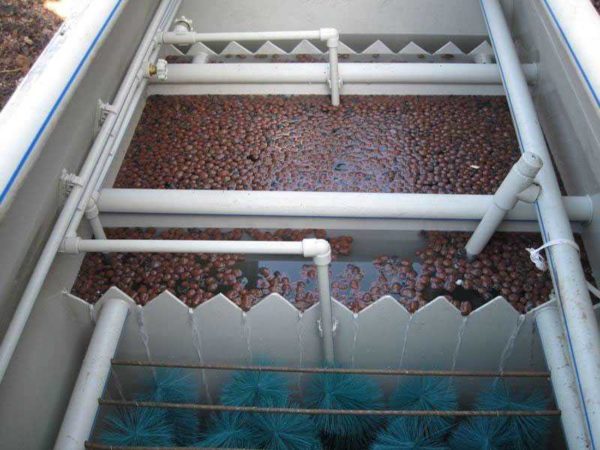
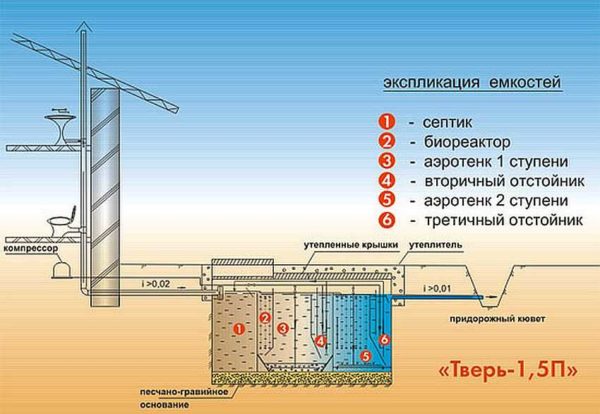
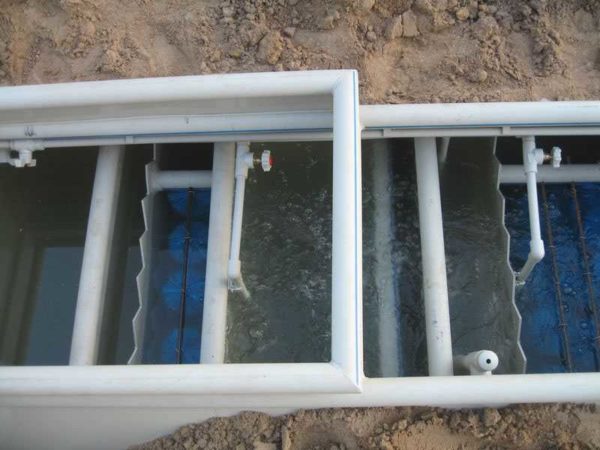
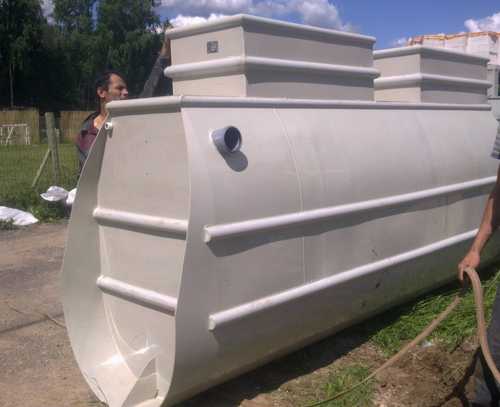
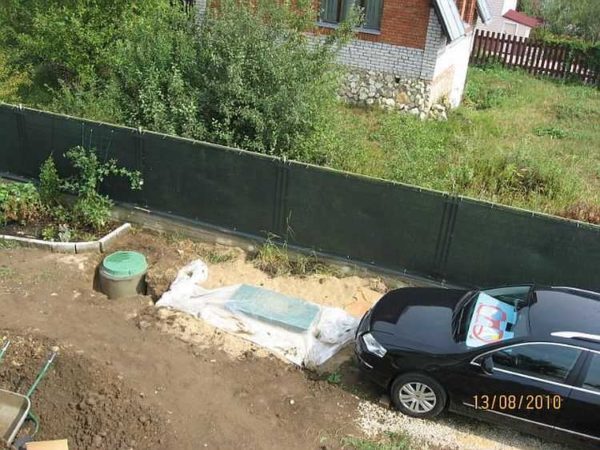
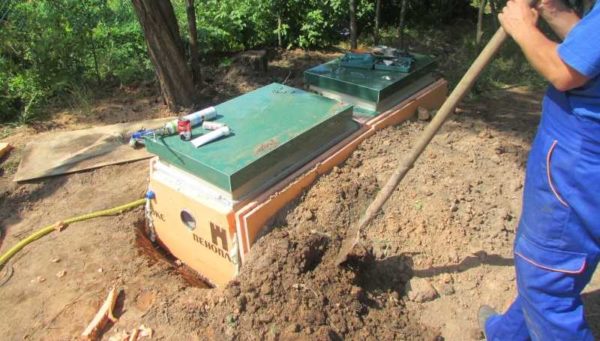
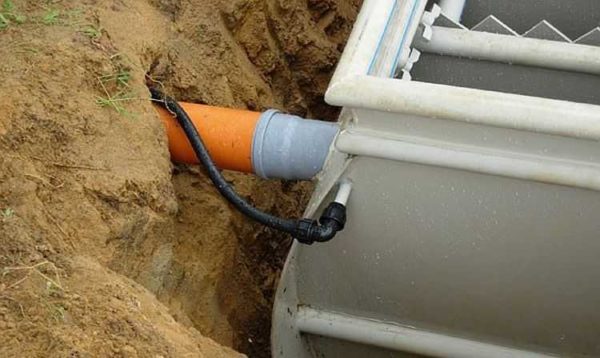
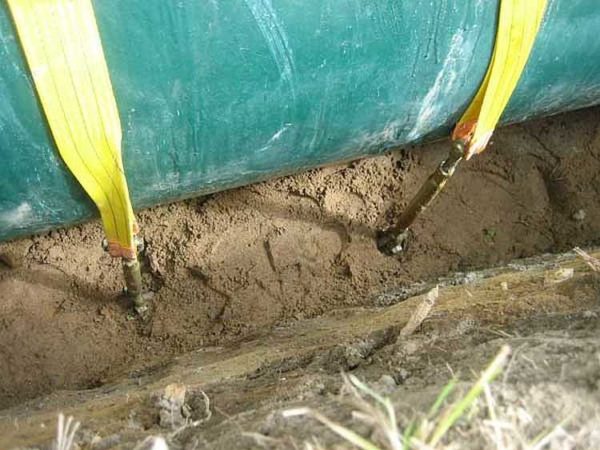
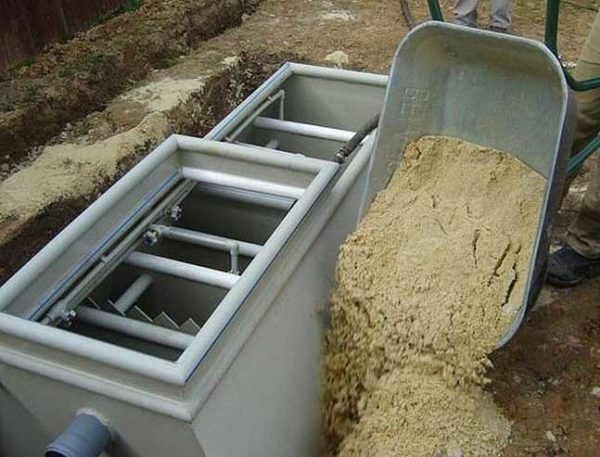
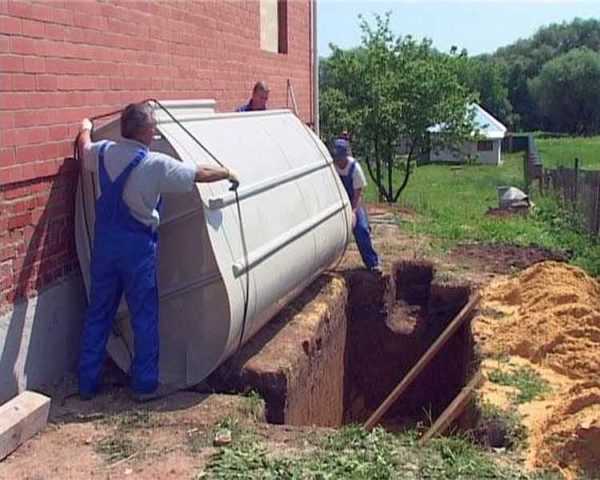
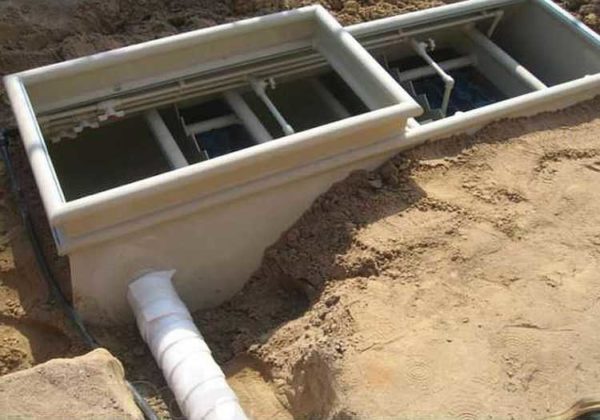
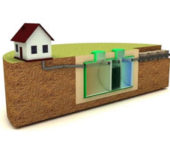
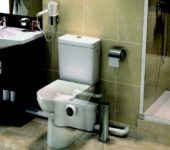
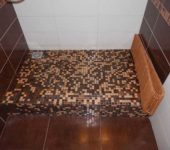
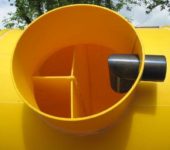
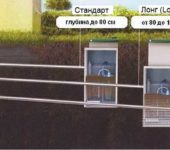





Average cost of installing a septic tank TVER 6P for 22-30 people
You need to call the companies that sell these septic tanks. They put them. Our site is informational. We collect information and try to give out all the positive and negative points. But we don't sell anything.